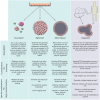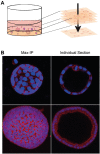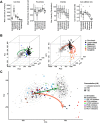3D Cell-Based Assays for Drug Screens: Challenges in Imaging, Image Analysis, and High-Content Analysis
- PMID: 30817892
- PMCID: PMC6589915
- DOI: 10.1177/2472555219830087
3D Cell-Based Assays for Drug Screens: Challenges in Imaging, Image Analysis, and High-Content Analysis
Abstract
The introduction of more relevant cell models in early preclinical drug discovery, combined with high-content imaging and automated analysis, is expected to increase the quality of compounds progressing to preclinical stages in the drug development pipeline. In this review we discuss the current switch to more relevant 3D cell culture models and associated challenges for high-throughput screening and high-content analysis. We propose that overcoming these challenges will enable front-loading the drug discovery pipeline with better biology, extracting the most from that biology, and, in general, improving translation between in vitro and in vivo models. This is expected to reduce the proportion of compounds that fail in vivo testing due to a lack of efficacy or to toxicity.
創薬の前臨床早期において、ハイコンテントイメージング自動アナリシスを併用しての適性度の高い細胞モデルの導入は、新薬開発パイプラインの前臨床段階に進む化合物の質を高めるものと期待される。本レビューでは、ハイスループットスクリーニングおよびハイコンテントアナリシスにおける、適性度の高い三次元細胞培養モデルへの現行の切り替えとそれに伴う課題について検討する。それらの課題を克服することで、適切なバイオロジーによる創薬パイプラインのフロントローディングが可能になり、そのバイオロジーから最大限のものを引き出し、概してin vivo外挿(translation between in vitro and in vivo models)を向上させることを我々は提案する。これにより、有効性欠如または毒性が原因でin vivo試験に不合格となる化合物の割合を低下できるものと期待される。
대용량 이미징과 자동화 분석과 함께 초기 임상 전 신약 개발에서 관련성이 더 높은 세포 모형을 도입하면 신약 개발에서 임상 전 단계로 넘어가는 물질의 품질을 높여줄 것으로 기대된다. 본 고찰에서는 관련성이 더 높은 3D 세포 배양 모형으로 넘어가고 있는 현재의 변화와 이에 따른 초고속 스크리닝 및 대용량 분석의 문제점을 논하고자 한다. 이러한 문제점을 극복하면 신약 개발의 초반 부분에 더 나은 세포 작용을 제공하고, 이러한 세포 작용에서 최대한 추출을 하고, 세포 및 동물 모형 사이의 중개를 개선시킬 것이라 제안한다. 이는 효능과 독성 때문에 동물 시험에서 실패하는 물질의 비율을 감소시킬 것으로 기대된다.
在早期临床前药物研发中引入相关性更好的细胞模型,结合高内涵成像和自动化分析,有望提高药物开发过程中进展至临床前阶段的化合物的质量。在本综述中,我们讨论了目前相关性更好的三维细胞培养模型的应用情况,以及相应高通量筛选和高内涵分析种的挑战。我们认为,克服这些挑战可以为药物研发流程提供更好的前期生物学基础,最大化的利用这些生物学基础,并在总体上改善从体外模型到体内模型的转换。预计这将减少因药效缺乏或毒性而在体内测试中失败的化合物的比例。
Keywords: 3D culture; 3D 배양; high-content screening; image analysis; imaging; イメージアナリシス; イメージング; ハイコンテントスクリーニング; 三次元細胞培養; 三维细胞培养; 关键词 高内涵筛选; 图像分析; 成像; 대용량 스크리닝; 이미지 분석; 이미징.
Conflict of interest statement
Figures





References
Publication types
MeSH terms
Substances
LinkOut - more resources
Full Text Sources

